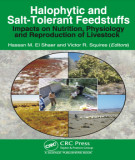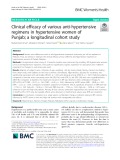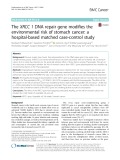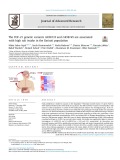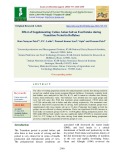
Salt intake
-
Part 2 book "Halophytic and salt tolerant feedstuffs impacts on nutrition, physiology and reproduction of livestock" includes content: Review of halophyte feeding trials with ruminants, intake and nutritive value of some salt tolerant fodder grasses and shrubs for livestock - selected examples from across the globe; halophyte and salt tolerant plants feeding potential to dromedary camels,... and other contents.
 240p
240p  oursky08
oursky08
 01-11-2023
01-11-2023
 4
4
 2
2
 Download
Download
-
The most frequently reported causes of extreme hypernatremia are accidental or intentional salt ingestion and diabetes insipidus, while dehydration due to poor water intake as a trigger for extreme hypernatremia is rarely documented.
 5p
5p  viintuit
viintuit
 26-09-2023
26-09-2023
 2
2
 0
0
 Download
Download
-
Iodine is an essential trace element, which is important for human metabolism, growth and men‑tal development. Iodine deficiency may still occur in Europe and the use of iodised salt is an effective measure to enhance iodine intake
 15p
15p  viferrari
viferrari
 29-10-2022
29-10-2022
 7
7
 2
2
 Download
Download
-
Bromide is a halide ion of the element bromine usually administered in the form of potassium salt as monotherapy or add-on treatment in epileptic dogs. It is excreted unchanged in the urine and undergoes tubular reabsorption in competition with chloride. Thus, dietary chloride content affects serum bromide concentrations.
 7p
7p  vidarwin
vidarwin
 23-02-2022
23-02-2022
 10
10
 1
1
 Download
Download
-
Currently, whether daily excess iodized salt intake increases the risk of thyroid nodules and even thyroid cancer remains controversial. Our research group aimed to provide a theoretical basis for the clinical guidance of daily iodized salt intake and the prevention of thyroid nodules through a retrospective analysis of the correlation between daily iodized salt intake and the risk of thyroid nodules and thyroid cancer in Hunan, China.
 15p
15p  vimahuateng
vimahuateng
 26-11-2021
26-11-2021
 14
14
 0
0
 Download
Download
-
Gender wise differences exist in anti-hypertensive treatment outcomes, yet still un-explored in Pakistan. Thus, we aimed to estimate the clinical efficacy of four different anti-hypertensive regimens in hypertensive women of Punjab, Pakistan.
 12p
12p  vitokyo2711
vitokyo2711
 31-08-2020
31-08-2020
 13
13
 3
3
 Download
Download
-
Previous studies have found that polymorphisms of the DNA repair gene X-ray repair crosscomplementing group 1(XRCC1) and environmental factors are both associated with an increased risk of stomach cancer, but no study has reported on the potential additive effect of these factors among Thai people.
 7p
7p  vimanama2711
vimanama2711
 30-07-2020
30-07-2020
 11
11
 2
2
 Download
Download
-
Food predilection is linked to variants in the hepatokine ‘‘Fibroblast Growth Factor-21” gene (FGF21); with rs838133 linked to the sweet tooth in Caucasians. The effect of FGF21 variants on food intake is still unclear in other populations. A cohort of 196 healthy Emirati subjects was investigated [age: 30.34 ± 9. 75yrs (44.4% males)]. The FGF21 rs838133 and rs838145 were genotyped. The daily intake was calculated based on a 61-item food frequency questionnaire.
 10p
10p  covid19
covid19
 14-06-2020
14-06-2020
 18
18
 0
0
 Download
Download
-
The effect of feeding prepartum anionic diet and postpartum cationic diet during transition period was studied using twenty pregnant Murrah buffaloes. Commonly available feeds and fodders were analyzed for their Na, K, Cl, and S content to calculate their Dietary Cation Anion Difference value. The buffaloes were divided into two equal groups and were fed with same diet.
 11p
11p  trinhthamhodang5
trinhthamhodang5
 16-05-2020
16-05-2020
 19
19
 1
1
 Download
Download
-
In connection with the global demand for safe human food and the production of environmentally friendly aquaculture products, acidifiers are natural organic acids and salts that have received considerable attention as animal-feed additives. The current study was designed to evaluate the effects of potassium diformate (KDF) on the growth performance and immunity of cultured Oreochromis niloticus (O. niloticus). Four iso-nitrogenous and iso-caloric rations containing graded levels of KDF, including 0% (control basal diet), 0.1%, 0.2% and 0.
 9p
9p  trinhthamhodang1
trinhthamhodang1
 16-11-2019
16-11-2019
 24
24
 3
3
 Download
Download
-
In 2008 the Cabinet Office published Food Matters: Towards a Strategy for the 21st Century (Cabinet Office 2008), which set out some of the concerns about current food consumption in the UK and its impact on health, and the economic, social and environmental sustainability of food production. It concluded that the current diet is not sustainable for either public health or the environment. In brief, the diet of the UK population is failing to meet dietary recommendations, with high intakes of saturated fat, sugar and salt, and low intakes of fruit and vegetables (Henderson et al.
 77p
77p  ut_hai_can
ut_hai_can
 26-12-2012
26-12-2012
 61
61
 5
5
 Download
Download
-
To answer the first question, dietary intake data from the National Diet and Nutrition Survey (NDNS) for adults aged 19-64 years (2000/01) was compared with nutrient recommendations for health and the Eatwell plate. This confirmed the fact that the UK diet is too high in saturated fat, sugar and salt, and low in fibre compared with dietary recommendations. Furthermore, a shift to more fruit, vegetables and starch-based food and to fewer high fat and/or sugar types of food and high protein-based food (particularly meat) is needed.
 0p
0p  ut_hai_can
ut_hai_can
 26-12-2012
26-12-2012
 45
45
 3
3
 Download
Download
-
Table 46-3 Causes of Hypokalemia I. Decreased intake A. Starvation B. Clay ingestion II. Redistribution into cells A. Acid-base 1. Metabolic alkalosis B. Hormonal 1. Insulin 2. β2-Adrenergic agonists (endogenous or exogenous) 3. α-Adrenergic antagonists C. Anabolic state 1. Vitamin B12 or folic acid (red blood cell production) 2. Granulocyte-macrophage colony stimulating factor (white blood cell production) 3. Total parenteral nutrition D. Other 1. Pseudohypokalemia 2. Hypothermia 3. Hypokalemic periodic paralysis 4. Barium toxicity III. Increased loss A.
 5p
5p  ongxaemnumber1
ongxaemnumber1
 29-11-2010
29-11-2010
 106
106
 5
5
 Download
Download
-
Hypovolemia Etiology True volume depletion, or hypovolemia, generally refers to a state of combined salt and water loss exceeding intake, leading to ECF volume contraction. The loss of Na+ may be renal or extrarenal (Table 46-1). Table 46-1 Causes of Hypovolemia I. ECF volume contracted A. Extrarenal Na+ loss 1. Gastrointestinal (vomiting, nasogastric suction, drainage, fistula, diarrhea) 2. Skin/respiratory (insensible losses, sweat, burns) 3. Hemorrhage B. Renal Na+ and water loss 1. Diuretics 2. Osmotic diuresis 3. Hypoaldosteronism 4. Salt-wasting nephropathies C.
 5p
5p  ongxaemnumber1
ongxaemnumber1
 29-11-2010
29-11-2010
 61
61
 4
4
 Download
Download
CHỦ ĐỀ BẠN MUỐN TÌM








